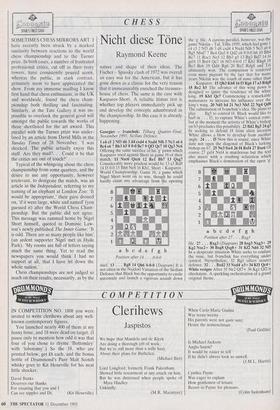Nicht diese Tone
Raymond Keene
SPAIN'S FINEST CAVA
SOMETIMES CHESS MIRRORS ART. I have recently been struck by a marked similarity between reactions to the world chess championship and to the Turner prize. In both cases, a number of frustrated professional critics, cut off in their ivory towers, have consistently poured scorn, whereas the public, in stark contrast, genuinely seem to have appreciated the show. From my immense mailbag I know first hand that chess enthusiasts, in the UK and worldwide, found the chess cham- pionship both thrilling and fascinating. Similarly, at the Tate Gallery it was im- possible to overlook the general good will amongst the public towards the works of those shortlisted for the art award. This parallel with the Turner prize was under- lined by an article from David Mills in the Sunday Times of 28 November: 'I was shocked. The public actually enjoy this stuff. Are they mad?. . Could it be that the critics are out of touch?'
Typical of the whingeing about the chess championship from some quarters, and the desire to use any opportunity, however irrelevant, to denigrate the match, was an article in the Independent, referring to my naming of an elephant at London Zoo: 'It would be appropriate,' their guru droned on, 'if it were large, white and named' (you guessed it) after the World Chess Cham- pionship. But the public did not agree. This message was rammed home by Nigel Short himself, quoted in Dominic Law- son's newly published The Inner Game: 'It is odd. There are so many people like him' (an ardent supporter Nigel met in Hyde Park). 'My rooms are full of letters saying much the same thing. Yet to read the. newspapers you would think I had no support at all, that I have let down the whole nation.'
Chess championships are not judged so much on their results, necessarily, as by the
nature and shape of their ideas. The Fischer — Spassky clash of 1972 was overall an easy win for the American, but it has gone down as a classic for the very reason that it immeasurably enriched the treasure- house of chess. The same is the case with Kasparov-Short. A reliable litmus test is whether top players immediately pick up and develop the concepts adumbrated in the championship. In this case it is already happening.
Georgiev — Ivanchuk: Tilburg Quarter-Final, November 1993; Sicilian Defence.
1 e4 c5 2 Nf3 d6 3 d4 cxd4 4 Nxd4 Nf6 5 Nc3 a6 6 Bc4 e6 7 Bb3 b5 8 0-0 Be7 9 Q13 Qc7 10 Qg3 Nc6 Offering the same sacrifice of his 'g' pawn which Kasparov tried against Short in game 16 of their match. 11 Nxc6 Qxc6 12 Rel Bbl 13 Qxg7 Considerably more prudent would be 13 a3 Rd8 14 f3 0-0 15 118h6 Ne8 16 Khl, Short — Kasparov, World Championship, Game 16, a game which Nigel Short went on to win, though he could hardly claim any advantage from the opening
duel. 13 . . . Rg8 14 Qh6 0-0-0 (Diagram) It is not often in the Najdorf Variation of the Sicilian Defence that Black has the opportunity to castle queenside and launch a vigorous assault down
the 'g' file. A curious parallel, however, was the game Nikitin — Tal, Tiflis 1959, which had gone 1 e4 c5 2 Nf3 d6 3 d4 cxd4 4 Nxd4 Nf6 5 Nc3 a6 6 Bg5 Nbd7 7 Bc4 Qa5 8 Qd2 e6 9 0-0 h6 10 Bh4 Be7 11 Rael Ne5 12 Bb3 g5 13 Bg3 Bd7 14 f4 gxf4 15 Bxf4 Qc7 16 NO 0-0-0 17 Khl Rhg8 18 Be3 Bc6 19 Qd4 Rg6 20 Re2 Rdg8 and Tal ultimately won. The comparison is rendered even more piquant by the fact that for many years Nikitin was the coach of none other than
. Kasparov. 15 Qh3 Kb8 16 13 Rg6 17 a3 Rdg8 18 Re2 h5 The advance of this wing pawn Is designed to ignite the residence of the white king. 19 Khl Qc7 Commencing a remarkable manoeuvre to increase his influence over the king's wing. 20 Ndl h4 21 Ne3 Nh5 22 Ng4 Qd8 The culmination of Ivanchak's idea. He plans to play . . . Bg5 to control f4. Black would like to hurl in . . . f5, to rupture White's central zone, but at the moment the activity of White's bishop on b3 precludes this possibility. 23 Bd2 Bg5 24 g3 In seeking to defend f4 from alien invasion White allows a blow to develop from another angle. 24 . . . f5 Now this is sound, since White dare not open the diagonal of Black's lurking bishop on b7. 25 Ne3 fxe4 26 f4 Bxf4 27 Bxe6 Of course 27 gxf4 Nxf4 is murderous but the text also meets with a crushing refutation which emphasises Black's domination of the open 'g
• Position after 27 . . . Rxg3
file. 27 . . . Rxg3 (Diagram) 28 hxg3 Nxg3+ 29 Kg2 Nxe2+ 30 Bxg8 Qxg8+ 31 Kf2 Nd4 32 N15 In a desperate situation White seeks to confuse the issue, but Ivanchuk has everything under control. Nevertheless, 32 Rgl offers stouter defence. 32 . . . Bxd2 33 Nxd4 e3+34 Kf1 Qc4+ White resigns After 35 Ne2 017+ 36 Kgl Qf2 is checkmate. A sparkling orchestration of a grand original theme.


































































 Previous page
Previous page